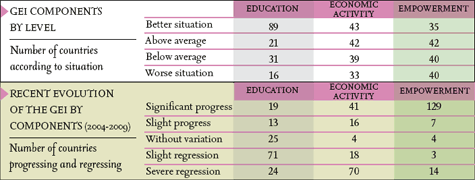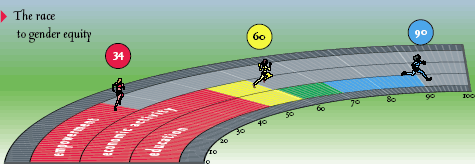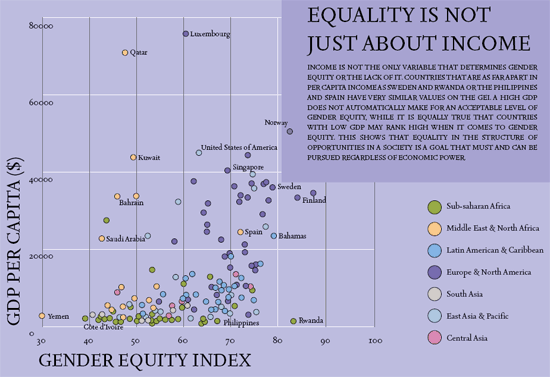THE THREE GAPS
THE GAP IN EDUCATION
We measure the gender gap in the following indicators:
• Literacy rate
• Enrolment rate in primary education
• Enrolment rate in secondary education
• Enrolment rate in tertiary education
source: unesco website database (www.uis.unesco.org), 2009.
Education is the sphere in which the gender equity gap has narrowed the most and in which more progress has been made. Yet, no country has reached the maximum value in this dimension.
Some 83 (41%) of the 202 countries observed are in the better situation and another 60 (30%) are above average. However, of the 173 countries for which it was possible to evaluate recent evolution the relative situation has worsened in 80 and there has been severe regression in 29, so overall some 63% of countries have regressed and in just over 16% the situation has remained unchanged.
When we take a broad geographical perspective we find that the most problematic regions in absolute terms are Sub-Saharan Africa and South Asia where 80% of the countries are below the average. In relative terms the least equitable region, where gender polarization is more extreme in the education area, is South Asia, where there are no countries in the slightly favourable situation (i.e. somewhat above the average).
evolution of the GEI components. |
 |
THE GAP IN ECONOMIC ACTIVITY
The estimation of the gender gap in economic activity is based on the gender gap in the following indicators.
• Rate of economic activity
• Estimated perceived income
source: unesco website database (www.uis.unesco.org), 2009.
Of the 163 countries considered, 96 (59%) regressed slightly or severely and only 63 (39%) made progress. When we consider the proportion of countries that have progressed against the far higher proportion that have regressed it is evident that a process of geographic polarization is taking place, and the region worst affected is Sub-Saharan Africa.
In some countries women participate in the labour market less today than they did five years ago, and this is reflected in a relative decrease in women’s average income since 2004. On the other hand there are countries where women’s participation in the labour market (excluding agriculture) is growing, and this is paralleled by a relative increase in women’s income when compared to men’s. This is an equity gap that is wider or narrower in different regions.
THE EMPOWERMENT GAP
The estimation of empowerment is based on the following indicators:
• % of women in technical positions
• % of women in management and government positions
• % of women in parliament
• % of women in ministerial level positions
sources: unesco website database (www.uis.unesco.org), 2009. ipu database (www.ipu.org) , 2009.
Women continue to be under-represented in decision making. Even in the countries in the better relative situation women have still not achieved parity with men in empowerment.
In the countries in the worse relative situation there are two diverging trends. Since 2008 there has been a slight improvement in women’s participation in the professions, the legislature, and high official and management positions, but the values show that these countries are still a very long way from acceptable levels of equity. In the last two indicators on the list, the percentages of women in parliament and in ministerial positions, the average values among countries in the worse relative situation have fallen alarmingly since 2008 (from 8.3 to 5.4 and from 9.6 to 6, respectively).
 |
|---|
GEI
In the world as a whole the gender gap in education is far narrower than the gaps in the other gender equity dimensions. While progress has been made in empowerment – mainly in terms of women’s increased participation in politics – the overwhelming majority of countries in the world have not attained minimum acceptable levels because the starting points have been so low. As to economic participation, the overall situation has worsened since 2008 and a high percentage of countries have actually regressed.
EDUCATION. Education is the dimension in which the gender equity gap has shrunk most. The problems that remain to be overcome in education are less severe than in the empowerment and economic activity dimensions.
ECONOMIC ACTIVITY. The progress that was made in 2008 in gender equity in economic activity was all but wiped out in 2009.
EMPOWERMENT. It is in access to decision-making spaces and the exercise of power that inequity between men and women is most evident. In no country do women have the same opportunities as men to participate in economic and social decision-making processes. However, in the last 15 years promising progress has been made in equity of access to political power in the widest sense of the term.
 |
|
GEI 2009
|
No progress there where it is needed the most |
Measuring inequity: the 2009 Gender Equity Index |
GEI regional average by component | THE THREE GAPS |
| Attachment | Size |
|---|---|
| GEI2009_ThreeGaps_eng.pdf | 467.01 KB |